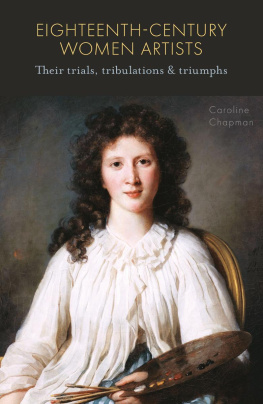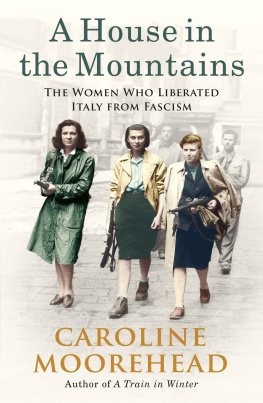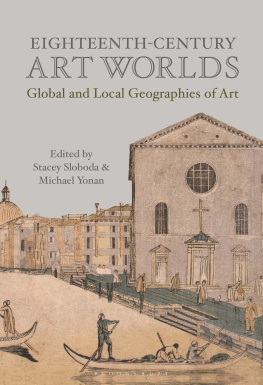Caroline Chapman - Eighteenth-Century Women Artists
Here you can read online Caroline Chapman - Eighteenth-Century Women Artists full text of the book (entire story) in english for free. Download pdf and epub, get meaning, cover and reviews about this ebook. year: 2017, publisher: Unicorn Publishing Group, genre: Non-fiction. Description of the work, (preface) as well as reviews are available. Best literature library LitArk.com created for fans of good reading and offers a wide selection of genres:
Romance novel
Science fiction
Adventure
Detective
Science
History
Home and family
Prose
Art
Politics
Computer
Non-fiction
Religion
Business
Children
Humor
Choose a favorite category and find really read worthwhile books. Enjoy immersion in the world of imagination, feel the emotions of the characters or learn something new for yourself, make an fascinating discovery.
- Book:Eighteenth-Century Women Artists
- Author:
- Publisher:Unicorn Publishing Group
- Genre:
- Year:2017
- Rating:5 / 5
- Favourites:Add to favourites
- Your mark:
- 100
- 1
- 2
- 3
- 4
- 5
Eighteenth-Century Women Artists: summary, description and annotation
We offer to read an annotation, description, summary or preface (depends on what the author of the book "Eighteenth-Century Women Artists" wrote himself). If you haven't found the necessary information about the book — write in the comments, we will try to find it.
Eighteenth-Century Women Artists — read online for free the complete book (whole text) full work
Below is the text of the book, divided by pages. System saving the place of the last page read, allows you to conveniently read the book "Eighteenth-Century Women Artists" online for free, without having to search again every time where you left off. Put a bookmark, and you can go to the page where you finished reading at any time.
Font size:
Interval:
Bookmark:

- Biographies of the principal
eighteenth-century women artists

Biographies of the principal
eighteenth-century women artists
Pauline Auzou (17751835)
Born in Paris, she was trained by Jean-Baptiste Regnault. By 1793 she was exhibiting at the Salon. She married Charles-Marie Auzou and gave birth to four children, but continued to paint. She maintained a school for women artists for twenty years. She executed portraits, genre scenes and history paintings.
Lady Diana Beauclerk (17341808)
Daughter of the 2nd Duke of Marlborough, she grew up at Blenheim Palace and made pastel studies of the family paintings. She married Topham Beauclerk in 1768 following her divorce from the 2nd Lord Bolingbroke. She is known for her images of cupids and children. Although an amateur, she may have sold some of her designs to Wedgwood later in life when she was short of money.
Marie-Guillemine Benoist (17681826)
Born in Paris, she studied first under Elisabeth Vige Le Brun and then Jacques-Louis David, whose work she emulated throughout her career. Her marriage to the royalist Pierre-Vincent Benoist in 1793 jeopardised her career during the Terror, which followed the Revolution, but she was later commissioned by Napoleon to paint portraits of himself and his family. She is best known for her sentimental genre scenes of women and children. She was awarded a gold medal in the Salon of 1804.
Marie-Genevive Bouliar (17621825)
Born in Paris, the only daughter of a tailor, Greuze is thought to have been one of her several teachers. Little is known about her career, but she exhibited at the Salon from 1791 to 1817. In 1795 she won a Prix dEncouragement. The few portraits known to be by her exhibit a warm sympathy for her subject, as demonstrated by her portrait of her friend Adlade Binart on the front cover.
Marie-Gabrielle Capet (17611817)
Born in Lyon into humble circumstances, she somehow escaped the provinces and went to Paris where she entered the studio of Adlade Labille-Guiard who not only taught her but promoted her and in every way changed her life. She began by painting portraits in pastel but converted to painting miniatures. She became one of the best and most popular miniature portraitists in Paris around the turn of the century.
Rosalba Carriera (16751757)
Born in Venice, where she remained for most of her life apart from spending a year in Paris in 1720 at the invitation of the French kings banker, Pierre Crozat, a year which made her name as a brilliant pastel portraitist. She also worked in Modena in 1723 and in Vienna in 1730. Her patrons included Grand Tourists visiting Venice and the Elector of Saxony for whom she did over 150 pastels. Unmarried, she was assisted by her sister. In 1746 her sight began to fail and by 1751 she was completely blind.
Marie-Anne Collot (17481821)
Born in Paris, she was trained by Jean-Baptiste Lemoyne, and the sculptor Etienne-Maurice Falconet. In 1766, aged eighteen, she accompanied Falconet to Russia as his assistant. For twelve years she executed portrait busts and medals for members of the court of Catherine the Great and assisted Falconet on his equestrian statue of Peter the Great. In 1778 she married Falconets son, but left him a year later. She gave up sculpting when Falconet became ill, nursing him for eight years until his death in 1791.
Maria Cosway (17591838)
Born in Florence, she studied with Violante Cerroti and Johann Zoffany. In 1779 she moved with her family to London. She married the miniaturist Richard Cosway in 1781 and they had one daughter who died in 1790. The Cosways were famous for their fashionable parties but by the 1790s had separated. She exhibited portraits and history pictures at the Royal Academy between 1781 and 1790. She founded a school for girls in Lyon (1803) and Lodi (1812). She returned to London in 1817 to nurse her dying husband. She died at Lodi.
Anne Seymour Damer (17481828)
The only woman sculptor of note in England until the twentieth century, she was born into an aristocratic Whig family. Taught by Giuseppe Ceracchi and John Bacon, she was an amateur sculptor of portrait busts and animals. She married the Hon. John Damer in 1767. She was childless and did not marry again after her husbands death. She exhibited at the Royal Academy as an amateur between 1785 and 1811.
Franoise Duparc (172678)
Although born in Spain, her family returned to their home town, Marseilles, in 1730. She received a basic artistic education from her sculptor father, and studied with the painter Jean Baptiste van Loo. She later moved to Paris. She was one of a small group of French artists who specialised in recording the lives of working-class people. She is known to have exhibited in Paris and London, but today only four works can definitely be attributed to her.
Anne Forbes (17451834)
Born in Scotland, she was financed by local businessmen to train in Rome, where she spent three years, returning to practise as a portraitist in London. But after a year of ill health and lack of clients, she returned to her native Edinburgh where she worked for the rest of her life. In 1772 she exhibited at the Royal Academy and became portraitist to the Society of Antiquaries of Scotland.
Marguerite Grard (17611837)
She was born in Grasse, Provence. When her older sister married Jean-Honor Fragonard, she moved to Paris to live with them and became Fragonards pupil. By the mid-1780s she was the leading female genre painter, executing over 300 genre scenes. Some of her work has been falsely attributed to Fragonard, although they are known to have collaborated on several paintings. She exhibited at the Salon between 1799 and 1824 and was awarded a gold medal in 1804.
Angelica Kauffman (17411807)
Born in Switzerland, she was taught by her artist father, who then took her to Italy to study the work of the great masters. In 1766 she came to England where she remained for fifteen years. Highly sought after as a fashionable portraitist, she was also one of the few women to succeed as a history painter. In 1768 she became a founder member of the Royal Academy. After a brief and disastrous marriage to an adventurer, she married the artist Antonio Zucchi in 1781. The couple left England and settled in Rome where she continued with her successful career. By the time of her death, she had achieved such renown that her funeral was directed by the prominent Neoclassical sculptor Antonio Canova.
Adlade Labille-Guiard (17491803)
Born in Paris, she trained with the miniaturist Franois-Elie Vincent, then the pastellist Maurice-Quentin de la Tour, and studied oil painting with Franois-Andr Vincent. In 1783 she became one of only two female members of the Acadmie Royale. In 1787 she was appointed official painter to Mesdames, Louis XVIs aunts. Her marriage in 1769 to Nicolas Guiard was unhappy and childless. She supported the Revolution and fought for the recognition of women artists. In 1800 she married Franois-Andr Vincent.
Constance Mayer (17751821)
Born in Paris, she studied with Greuze, Joseph-Benot Suve and briefly in 1801 with David. In 1802 she became the pupil of Pierre-Paul Prudhon. She collaborated with him professionally and helped to look after his family. At the Salon she exhibited miniatures, genre paintings, allegorical subjects and portraits. She committed suicide when Prudhon refused to marry her after his wifes death.
Font size:
Interval:
Bookmark:
Similar books «Eighteenth-Century Women Artists»
Look at similar books to Eighteenth-Century Women Artists. We have selected literature similar in name and meaning in the hope of providing readers with more options to find new, interesting, not yet read works.
Discussion, reviews of the book Eighteenth-Century Women Artists and just readers' own opinions. Leave your comments, write what you think about the work, its meaning or the main characters. Specify what exactly you liked and what you didn't like, and why you think so.





